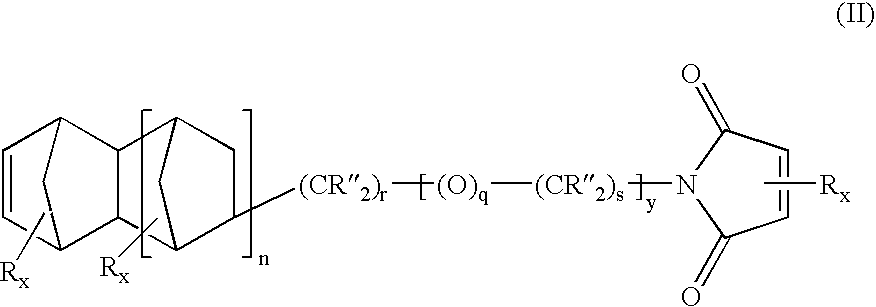Heterobifunctional monomers and uses therefor
- Summary
- Abstract
- Description
- Claims
- Application Information
AI Technical Summary
Benefits of technology
Problems solved by technology
Method used
Image
Examples
example 1
[0227]This example describes the synthesis of the heterobifunctional monomer, N-(5-norborn-2-en-yl) maleimide, shown below:
[0228]A. Preparation of 5-methylamino-norbornene. Allylamine (113 g, 1.98 mol) and dicyclopentadiene (DCPD) (65 g, 0.49 mol) were placed into an autoclave and heated to 220° C. for 24 hours. Excess allylamine was removed by distillation at atmospheric pressure. The 1:1 cyclopentadiene:allylamine Diels-Alder adduct was purified by vacuum distillation (55 g collected at 55-65° C. at 1 mm Hg). 1H and 13C NMR data were consistent with that expected for the 1:1 Diels-Alder adduct of cyclopentadiene and allylamine (see Sagane, Makromol. Chemie, 1993, 194, 37). Infrared spectroscopy confirmed the presence of the amino functional group.
[0229]B. Preparation of N-(5-norborn-2-en-yl) maleimide. Maleic anhydride (14.7 g, 0.150 mol) was dissolved in toluene (100 ml) in a two-neck round bottom flask. To this solution was slowly added CH3SO3H (5.8 ml, 0.090 mol) followed by N...
example 2
Copolymerization of Norbornene and N-(5-norborn-2-en-yl)maleimide
[0230]N-(5-norbornene-2-en-yl) maleimide (1.0 g, 4.9 mmol) and norbomene were weighed into a 100 ml septum-capped vial equipped with a stir bar. The vial was purged with argon for 15 min and the vial was re-weighed to determine the actual amount of norbomene remaining in the vial, i.e., 0.78 g, 8.3 mmol (norbomene is volatile, therefore some of this monomer was lost during the argon purge). To the vial was added chlorobenzene (2 mL, chlorobenzene was dried over CaH2 prior to use). The catalyst system, i.e., (allyl)PdCl (39 mg, 0.11 mmol) and AgSbF6 (98 mg, 0.29 mmol) (see Risse, et. al., Macromolecules, 1996, 29, 2755) was weighed into a separate septum-capped vial and immediately purged with argon. After a 15 min purge, chlorobenzene (2 mL) was added to the catalyst mixture, and this mixture was allowed to stir at room temperature for 30 minutes. The catalyst solution was injected into the monomer solution using a syr...
example 3
Copolymerization of 5-n-butyl-norbornene and N-(5-norborn-2-en-yl)maleimide
[0231]N-(5-norbornene-2-en-yl) maleimide (44 g, 0.20 mol) and 5-n-butyl-norbomene (44 g, 0.30 mol) were weighed into a two-neck round bottom flask and immediately placed under an atmosphere of argon. Via cannula, 1-hexene (124 mL, 1.0 mol) was added as a chain transfer agent, followed by the reaction solvent CH2Cl2 (300 mL, dried over CaH2 prior to use). The catalyst system, (allyl)PdCl (0.90 g, 2.5 mmol) and AgSbF6 (2.3 g, 6.8 mmol) was prepared and introduced to the polymerization flask as described in Example 2. The polymerization was allowed to proceed for 48 hrs.
[0232]The polymerization solution was poured into a large excess of acetone (1 L) to precipitate the polymer and remove unreacted monomer and catalyst residues. The polymer was isolated by filtration and dried in vacuo at room temperature overnight. In this manner 48 g (55% yield) of a white solid was obtained. Infrared spectroscopy and 1H and 13...
PUM
| Property | Measurement | Unit |
|---|---|---|
| Temperature | aaaaa | aaaaa |
| Composition | aaaaa | aaaaa |
| Electrical resistance | aaaaa | aaaaa |
Abstract
Description
Claims
Application Information
 Login to View More
Login to View More - R&D
- Intellectual Property
- Life Sciences
- Materials
- Tech Scout
- Unparalleled Data Quality
- Higher Quality Content
- 60% Fewer Hallucinations
Browse by: Latest US Patents, China's latest patents, Technical Efficacy Thesaurus, Application Domain, Technology Topic, Popular Technical Reports.
© 2025 PatSnap. All rights reserved.Legal|Privacy policy|Modern Slavery Act Transparency Statement|Sitemap|About US| Contact US: help@patsnap.com



